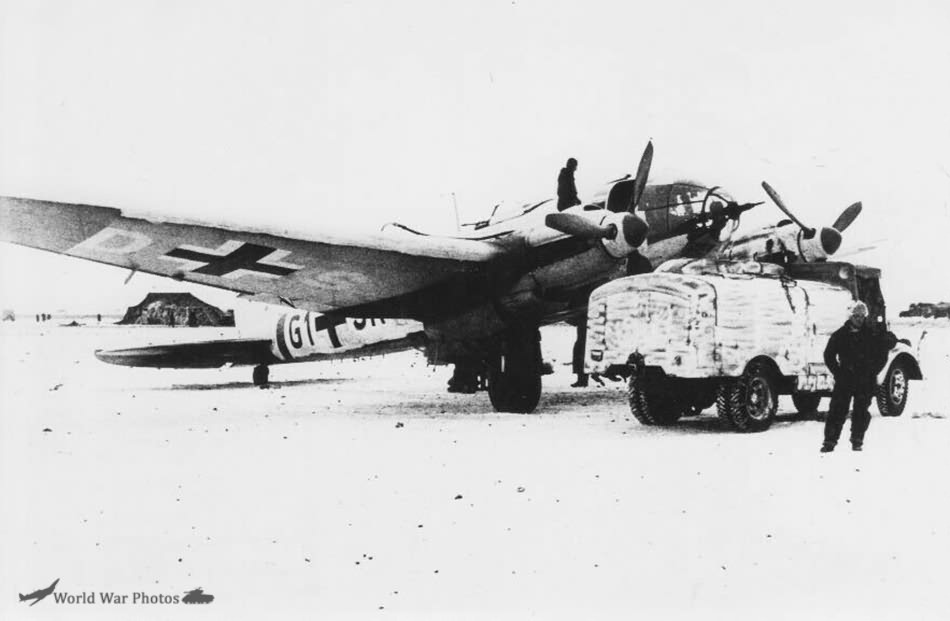The harsh realities of combat, particularly on the Eastern Front, necessitated the rapid adaptation of the Heinkel He 111’s camouflage schemes to counter the severe winter conditions. The standard dark green/black-green temperate finish, with which most He 111s began Operation Barbarossa, quickly proved inadequate against the snow-covered landscapes, leading to the widespread adoption of various temporary winter camouflage patterns.
Evolution and Application of Winter Camouflage
Initially, winter camouflage was often an improvised measure. This initial white paint often had a pristine appearance, though it would not remain so for long in operational conditions.
As the war progressed, the methods and patterns evolved:
- All-Over White: Many He 111s, particularly those operating during the depths of the Russian winter, adopted an overall white finish. This was notably seen during critical supply missions, such as the Stalingrad airlift.
- Patches, Scribbles, and Dots: More elaborate and sometimes crude applications of winter camouflage emerged. These included patchwork, scribble schemes, and polka-dotted patterns over the basic camouflage. These variations suggest a more ad-hoc application, often done by groundcrews in the field, sometimes in a terrible hurry or without full dedication. One example shows a “mad mix of patches, scribbles and dots” covering a He 111H-16 in March 1944. Another featured an “exuberant pattern of ‘patches and lines'”.
- “Wave” Pattern: Some units, like I. and III. Gruppen of KG 55 in the Crimea towards the end of 1943, favored a striking “wave”-pattern camouflage. This “all-purpose” scheme was designed to suit their diverse operations over both land and water.
- Retention of Summer Camouflage: Despite the clear need for winterization, some strategic bomber force Heinkels as late as May 1944 were still wearing “temporary” winter camouflage schemes, adopted during earlier training, which could include hard-edged white and darker green patches.
Challenges and Operational Impact
The effectiveness of these camouflage efforts was often tested by the severe weather. Plummeting temperatures made it harder to start engines, and icing became a major problem, leading to significant aircraft losses. For example, during an eight-day period in the Stalingrad airlift, 62 aircraft were lost to icing alone. Groundcrews endured brutal conditions, often working through the night, suffering frostbite when forced to use bare hands to check engines and radio equipment. Weapons also froze and oil solidified.
The Auffrischungsstab Ost, responsible for training new He 111 strategic bomber crews in Poland during the winter of 1943-44, issued new He 111H-16s and H-20s to units, emphasizing training in night landings and instrument flying due to the harsh conditions. This highlights that winter operations, regardless of camouflage, were inherently challenging.
While some aircraft were equipped with flame exhaust dampers to reduce visibility during night operations, the primary camouflage against snow and ice was the various white and broken patterns. Some machines also had black undersides suitable for night operations.
In some instances, the distinctiveness of early radio-navigation equipment, such as the “three prominent dorsal aerials” of the X-Gerät-equipped He 111s, remained visible even after the equipment was removed, as there was often not enough time to completely de-modify the aircraft before hasty transfers to fronts like Moscow. These visible features would contrast with the winter camouflage.
Overall, winter camouflage on the He 111 was a dynamic and often improvised response to the extreme environmental challenges of the Eastern Front, evolving from simple white wash to more complex patterns, all aimed at improving the aircraft’s survivability in a hostile, snow-covered environment.
